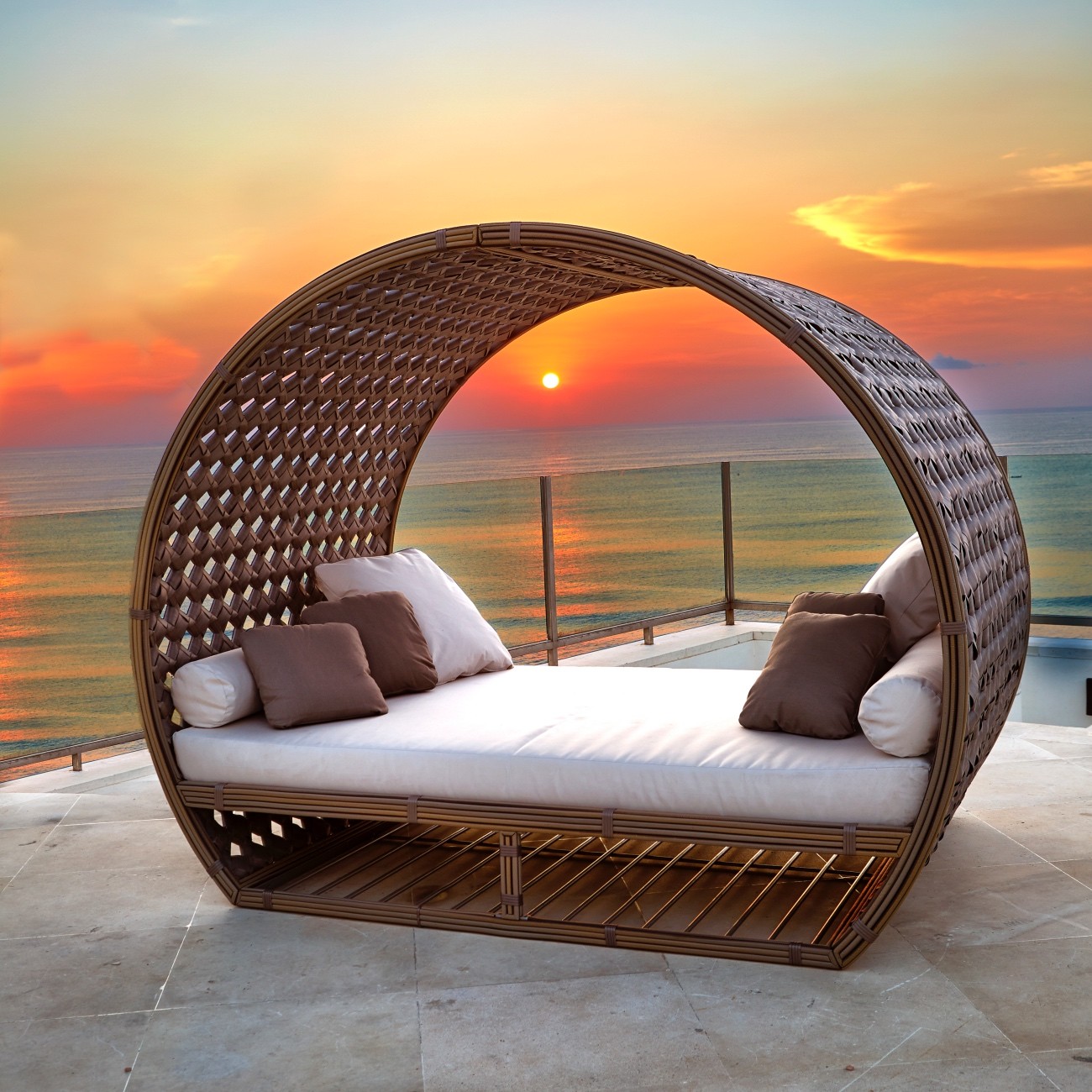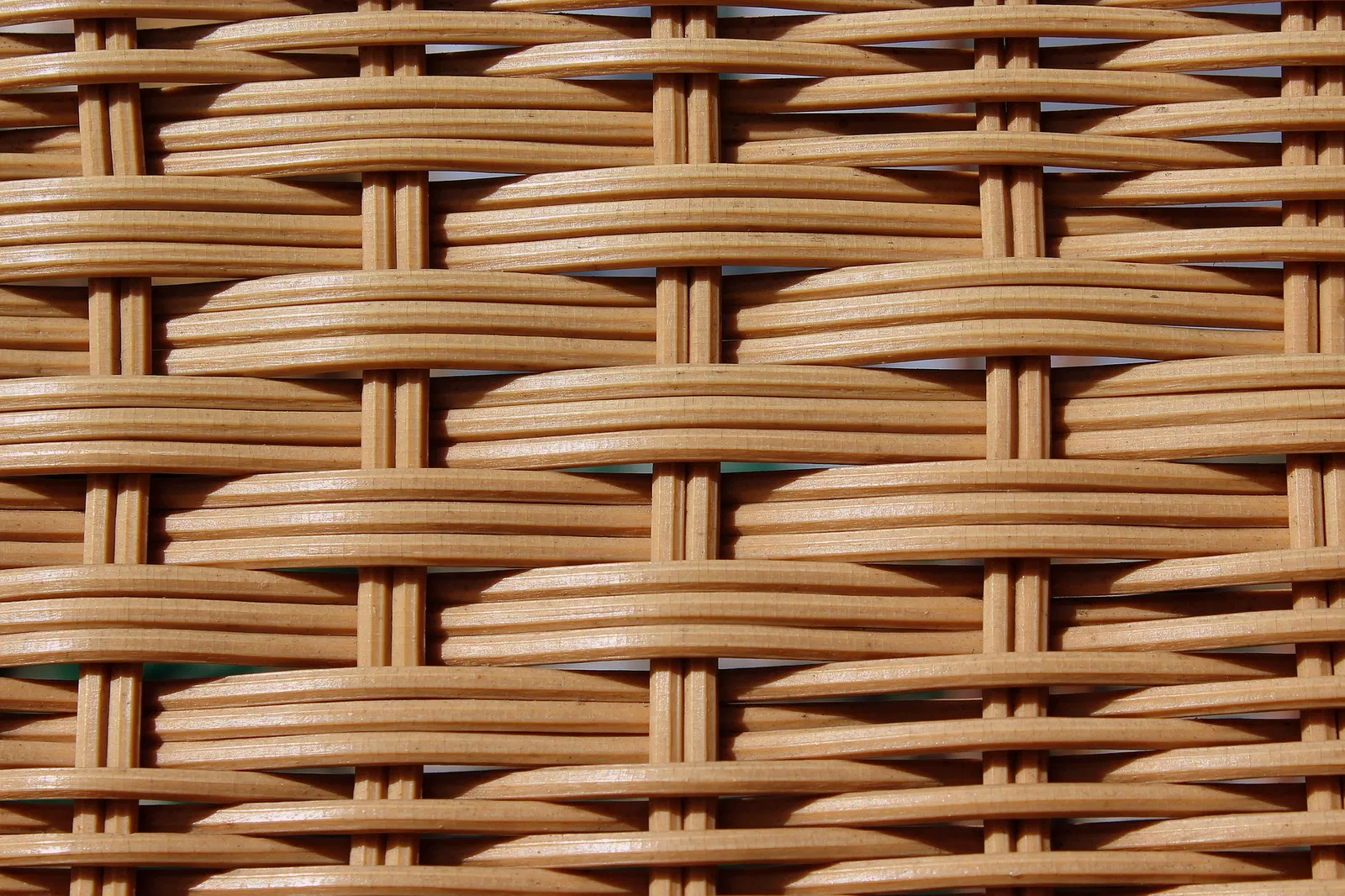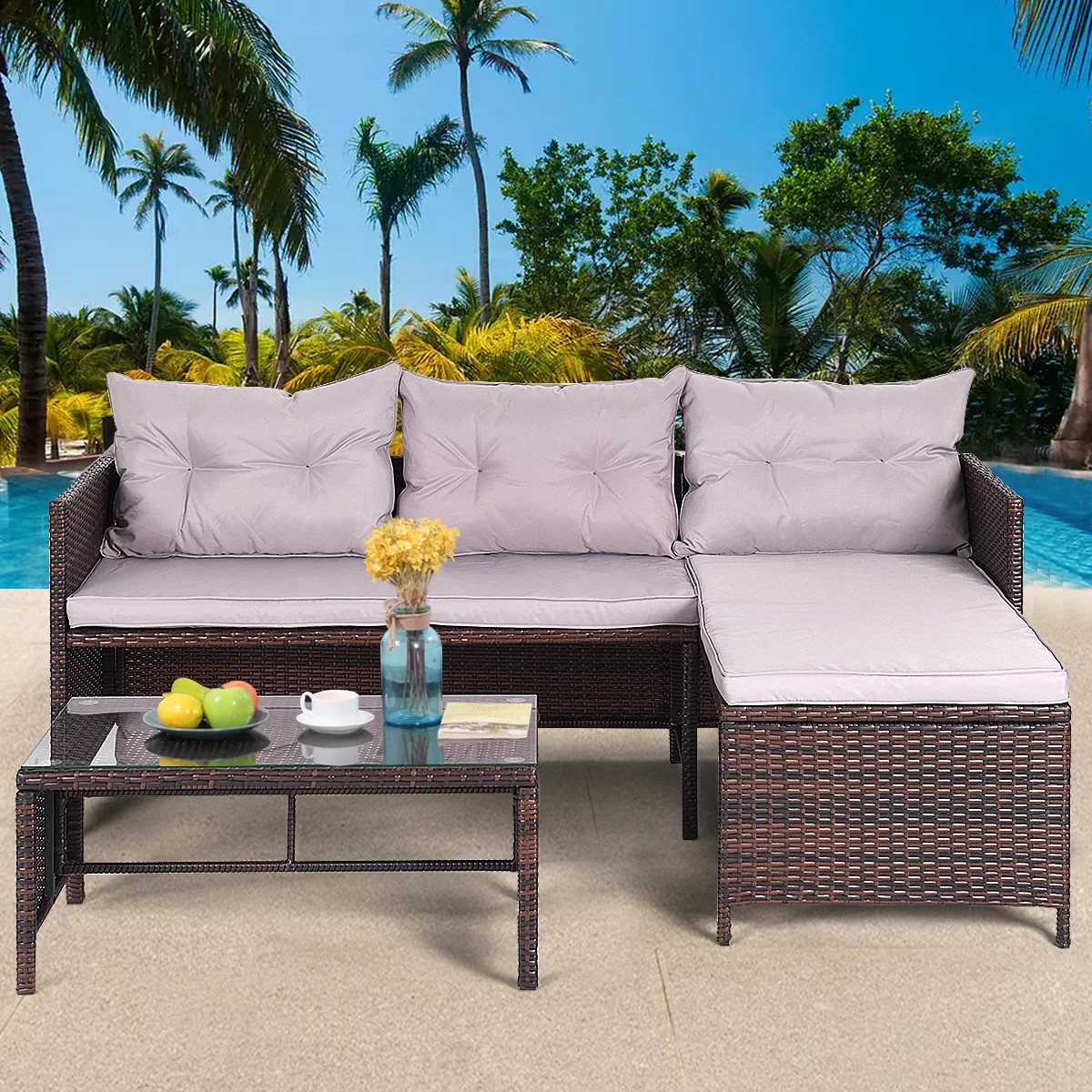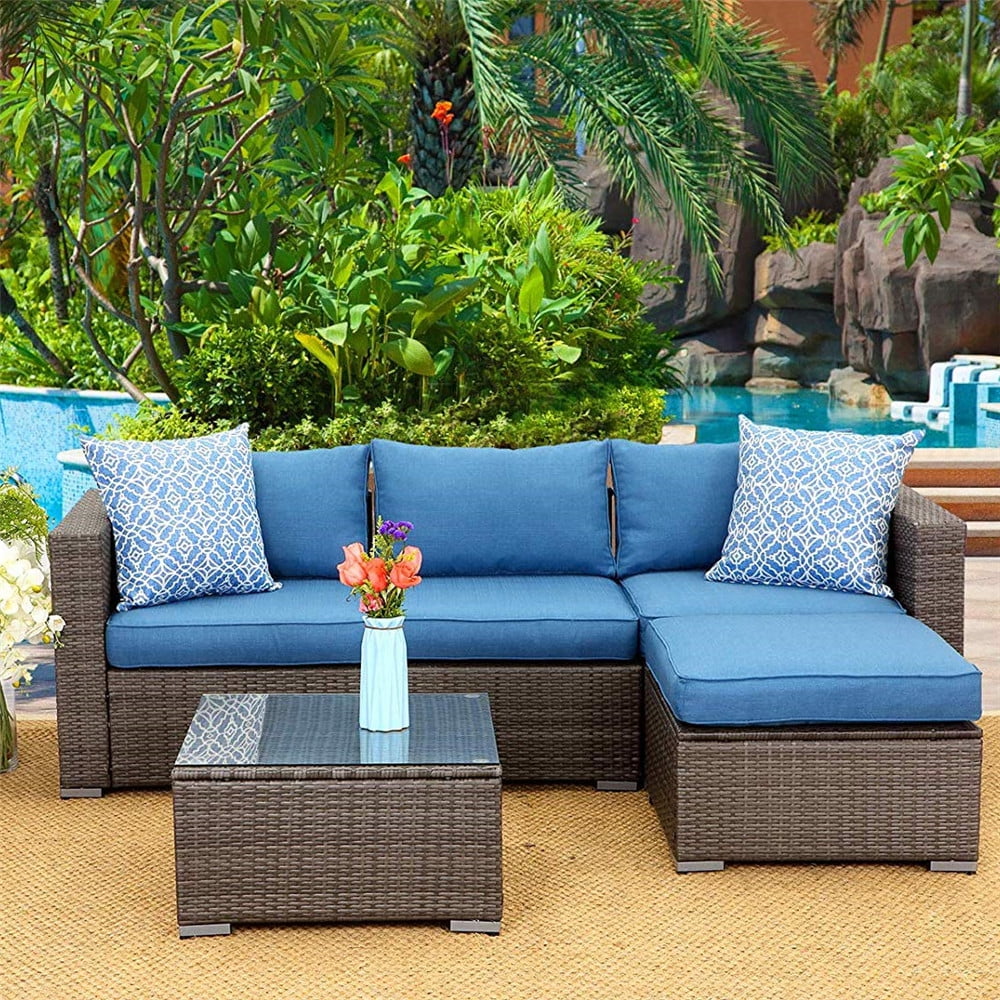
When it comes to choosing the perfect furniture material for your patio, wicker and rattan are often the top choices. Both materials have a unique natural beauty and can bring comfort and elegance to outdoor spaces. But which material is better for patio furniture? Let's take a deep dive into the definition, history, pros and cons, and care details of wicker and rattan to help you make an informed choice.

What is Wicker Furniture?
Wicker furniture is furniture made from woven willow branches. This type of furniture is widely popular because of its lightness, flexibility, and natural appearance. Wicker furniture is often used for outdoor and indoor decoration, especially in gardens, balconies, and terraces. Due to the natural flexibility and plasticity of wicker, the furniture made is not only comfortable, but also has a natural beauty and texture.
History - The history of wicker furniture can be traced back to ancient Egypt and Rome, when the nobility and wealthy class began to use woven furniture as home decoration. Over time, the production technology of wicker furniture has been continuously improved and gradually became popular in Europe and Asia. In 18th century Europe, especially during the Victorian era, wicker furniture became a popular choice in the courtyards and gardens of the upper class.
In the early 20th century, with the advancement of the Industrial Revolution, wicker furniture production gradually became mechanized, which made this furniture more popular. Especially in the United States, wicker furniture is widely used in indoor and outdoor decoration, becoming a signature element of pastoral style and seaside vacation homes.
Types - There are two main types of wicker furniture: natural wicker and synthetic wicker. Natural wicker furniture is woven from real willow branches, retaining its natural texture and beauty. Synthetic wicker furniture uses materials such as high-density polyethylene (HDPE) to imitate the look and feel of natural wicker, with better weather resistance and durability.
Furniture products made of wicker
Wicker furniture can make a variety of products according to the purpose and design style. Common ones include:
● Outdoor furniture: such as patio chairs, rocking chairs, lounge chairs and tables, suitable for outdoor environments such as terraces and gardens.
● Indoor furniture: such as sofas, chairs, coffee tables and bookshelves, often used in indoor spaces such as living rooms and sun rooms.
● Decorations: Small home decorations such as lampshades, flower baskets and screens.
Colors - Natural wicker furniture usually presents natural wood tones such as light brown, beige and gray. Synthetic wicker furniture can be made into a variety of colors as needed, with white, black, dark brown and gray being the most common.
Applications - Wicker furniture is widely used in various indoor and outdoor scenes, such as gardens, balconies, terraces, living rooms and bedrooms. Because it is light and easy to move, wicker furniture is particularly suitable for spaces that need to be rearranged frequently.
In addition, wicker furniture is also widely used in commercial places, such as outdoor dining areas in cafes, restaurants and hotels. Its light and durable characteristics make it an ideal choice for these places.

What is Rattan Furniture?
Rattan furniture is furniture woven from the stems of vine plants. Rattan is a climbing plant that grows in tropical areas. Its stems are tough and flexible, making it very suitable for making furniture. This type of furniture is known for its lightness, strength, flexibility and breathability. The natural toughness of rattan allows it to be bent into various shapes, creating artistic curves and textures.
History - Rattan furniture has an equally long history. As early as the 3rd century BC, the ancient Greeks and Romans began to use rattan to make furniture. Over time, the production process of rattan furniture has been continuously improved, and the design has become more complex and diverse. In ancient times, rattan was widely used to make baskets, mattresses, cushions and other daily necessities.
With the exchange of Eastern and Western cultures, rattan furniture gradually spread to Europe. In the 17th century, European colonists discovered the uniqueness of rattan furniture in Southeast Asia and brought it back to Europe, becoming the darling of the court and the nobility. By the 19th century, rattan furniture was popular in Victorian Britain and other European countries, becoming a fashionable home decoration choice.
Types - Rattan furniture is mainly divided into two types: natural rattan and synthetic rattan. Natural rattan furniture is woven from real vine plant stems and has a unique natural texture and texture. Synthetic rattan furniture uses materials such as polyethylene to imitate the look and feel of natural rattan, with better weather resistance and durability.
Furniture products made of rattan
Like wicker, rattan can be used to make furniture of many products. Common ones include:
● Indoor furniture: including sofas, chairs, coffee tables and storage racks, etc., commonly used in living rooms, bedrooms and sun rooms.
● Outdoor furniture: such as patio chairs, rocking chairs, lounge chairs and dining tables and chairs, suitable for gardens, balconies and terraces.
● Decorations and accessories: such as lampshades, flower baskets, mirror frames and screens, used to add decorativeness to the room.
Color - Natural rattan furniture usually retains the natural tones of the vine, such as light yellow, light brown and gray. Synthetic rattan furniture can be made into a variety of colors as needed, and the most common ones are white, black, dark brown and gray.
Application - Rattan furniture is widely used in various indoor and outdoor scenes, such as gardens, balconies, terraces, living rooms and bedrooms. Due to its tough and elastic characteristics, rattan furniture is particularly suitable for making furniture that requires a certain degree of flexibility and comfort, such as sofas, chairs and rocking chairs.

Advantages and Disadvantages of Wicker Furniture
Advantages of Wicker Furniture
Natural Beauty: Wicker furniture has a unique natural texture and texture, which can add a natural beauty to indoor and outdoor spaces.
Light and easy to move: Wicker furniture is relatively light and easy to move and rearrange, making it ideal for spaces that require frequent layout changes.
Good breathability: The woven structure of wicker furniture is ventilated and breathable, especially suitable for summer use, and can provide a comfortable sitting feeling.
Environmentally friendly and sustainable: Natural wicker furniture is made of renewable resources and is environmentally friendly.
Disadvantages of wicker furniture
Afraid of moisture: Wicker furniture is prone to mold in a humid environment, so you need to pay attention to moisture-proof.
Easy to break: Although wicker furniture is durable, it may break or wear out during long-term use and requires regular maintenance.
Weak support: Wicker furniture is not as supportive as rattan furniture, and may be deformed or damaged after long-term use.
| Advantages of wicker furniture | Disadvantages of wicker furniture |
| Unique natural texture and feel | Afraid of moisture, prone to mold |
| Lightweight and easy to move | May break or wear out after long-term use |
| Good air permeability, especially suitable for summer use | Weak support, not as good as rattan furniture |
| Natural wicker is environmentally friendly and sustainable |

Advantages and Disadvantages of Rattan Furniture
Advantages of rattan furniture
Diverse design: Rattan furniture can be woven into a variety of complex patterns and shapes, with a variety of design styles.
Natural beauty: Rattan furniture retains the natural texture and texture of vines, which can add a natural beauty to indoor and outdoor spaces.
Good elasticity: Rattan furniture is elastic and can provide a comfortable sitting feeling and support.
Heat and sun resistance: rattan furniture has good resistance to heat and sunlight and is suitable for outdoor use.
Disadvantages of rattan furniture
Heavy weight: rattan furniture is relatively heavy, not as light as wicker furniture, and it is inconvenient to move and rearrange.
High price: the production process of rattan furniture is relatively complicated, the cost is high, and the selling price is relatively expensive.
Afraid of dryness: rattan furniture is prone to cracking in an overly dry environment and needs to maintain a certain humidity.
Easy to be eaten by insects: rattan furniture is easily eaten by insects in a humid environment and needs to be treated with insects regularly.
| Advantages of rattan furniture | Disadvantages of rattan furniture |
| Various designs (complex patterns and shapes) | Heavier weight, not as light as wicker furniture |
| Natural texture and feel of rattan | Higher price (complex manufacturing process) |
| Good elasticity, comfortable sitting | Easy to crack in dry environment |
| Heat and sun resistance, good resistance to heat and sunlight | Easy to be eaten by insects in humid environment |
How Many Years Can Wicker and Rattan Furniture be Used?
The service life of wicker and rattan furniture mainly depends on its material, use environment and maintenance.
Service life of wicker furniture
● Indoor use: When natural wicker furniture is used indoors, the service life is generally 5-10 years. The service life of synthetic wicker furniture is longer, up to 15-20 years.
● Outdoor use: When natural wicker furniture is used outdoors, it has a shorter service life due to the influence of weather and environment, generally 3-5 years. Synthetic wicker furniture has better weather resistance and can last up to 10-15 years.
Lifespan of rattan furniture
● Indoor use: Natural rattan furniture has a service life of 10-15 years when used indoors. Synthetic rattan furniture has a longer service life of 20-25 years.
● Outdoor use: Natural rattan furniture has a shorter service life when used outdoors, generally 5-7 years. Synthetic rattan furniture has better weather resistance and can last up to 15-20 years.
Main Differences Between Wicker and Rattan
Types - Willow comes mainly from willow trees, while rattan comes from rattan plants.
Wicker: Willow comes mainly from the branches of willow trees and has good flexibility and plasticity.
Rattan: Rattan comes mainly from the stems of vines in tropical areas and has the characteristics of toughness and elasticity.
Color - The color of wicker is usually pale yellow or light brown, while the color of rattan is more diverse.
Wicker: Wicker furniture usually presents natural wood tones such as light brown, beige and gray.
Rattan: Rattan furniture usually retains the natural tones of the vine, such as light yellow, light brown and gray.
Texture - Wicker is more flexible but relatively brittle; rattan is tough and resilient.
Wicker: Wicker furniture is lighter and more flexible, but has relatively weaker support.
Rattan: Rattan furniture is tougher, has good support and elasticity, but is heavier.
Price - Rattan furniture is usually slightly more expensive than wicker furniture, mainly due to the scarcity of rattan materials and the complexity of the weaving process.
Wicker: Wicker furniture is relatively inexpensive to make and relatively cheaper to sell.
Rattan: The manufacturing process of rattan furniture is relatively complex, the cost is higher, and the selling price is relatively expensive.
Lifespan - Rattan furniture usually has a longer lifespan than wicker furniture with proper care.
Wicker: Wicker furniture has a relatively short lifespan, especially in outdoor environments.
Rattan: Rattan furniture has a relatively long lifespan, especially synthetic rattan furniture has good weather resistance.
| Category | Wicker furniture | Rattan furniture |
| Type | Wicker mainly comes from willow trees | Rattan comes from rattan plants |
| Color | Pale yellow or light brown | Rattan has a variety of colors |
| Texture | Wicker is more flexible but relatively brittle | Rattan is tough and flexible |
| Price | Wicker furniture is cheaper | Rattan furniture is more expensive |
| Lifespan | Wicker furniture has a shorter lifespan (3-5 years outdoors) | Rattan furniture has a longer lifespan (5-7 years outdoors) |
| Maintenance and care | Avoid placing in a humid environment | Spray insect repellent regularly to prevent insects from eating |

Maintenance and Care: Keep Wicker and Rattan Furniture in Top Condition
Maintenance details for wicker furniture
1. Regular cleaning: Use a soft cloth to gently wipe wicker furniture to avoid dust accumulation.
2. Moisture and mildew prevention: Keep the furniture dry and avoid placing it in a humid environment.
3. Sun protection: Avoid prolonged exposure to the sun to prevent the wicker from becoming brittle and fading.
4. Regular maintenance: Check if the wicker is broken or loose, and repair it in time.
Maintenance details for rattan furniture
1. Maintain humidity: In a dry environment, you can use a damp cloth to gently wipe the rattan furniture to keep it moderately moist.
2. Insect prevention treatment: Spray insect repellent regularly to prevent insect infestation.
3. Sun protection and crack prevention: Avoid prolonged exposure to the sun to prevent the rattan from cracking and fading.
4. Regular cleaning: Use a soft cloth and warm water to wipe the rattan furniture to avoid dust and dirt accumulation.
Therefore, if you value the lightness and natural beauty of furniture, you can choose wicker furniture; if you value the durability and support of furniture, you can choose rattan furniture. No matter which material you choose, regular cleaning and maintenance are the key to keeping the furniture beautiful and durable.

